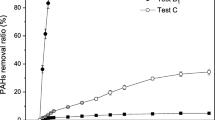Abstract
This paper reports pioneering work in identifying an alternative coagulation agent of wastewater treatment, given the availability of commonly used agents are of a higher cost relative to more natural sources, such as soil. The alternative proposed is laterite soil from northern Malaysia because it contains high amounts of Al and Fe, which are well-known coagulants. The soil was grinded and sieved to obtain uniform particle sizes of <250 μm. Al and Fe were extracted from the soil. Extraction agents: (1) HCl, (2) NaOH, and (3) HCl + NaCl were chosen. It was found that the most effective agent to extract Fe was 5 N HCl while to extract Al was HCl + NaCl, 2 and 4 N, respectively. D-optimal design observed that extraction time t, temperature T, and ratio of amount of laterite soil to amount of extractants r, showed a significant effect on Al extraction. In contrast, the combination of factors t and r exhibited insignificant effect on Fe extraction while other factors were significant. The optimum conditions for extraction of both Al and Fe were 90 °C, 40 min, for r = 1:15, which gave [Fe] = 1,870 mg/l and [Al] = 0.17 mg/l and 90 °C, 90 min, for r = 1:10, which gave [Fe] = 2,900 mg/l and [Al] = 0.130 mg/l. Since concentration of Fe extracted from laterite soil was high, it was concluded that laterite soil can be considered as an alternative and novel source of coagulant applicable in a wastewater treatment coagulation process.





Similar content being viewed by others
References
Bhattacharya P (2007) Arsenic in soil and groundwater environment: biogeochemical interactions, health effects and remediation. Trace metals and other contaminants in the environment, vol 9. Elsevier, Amsterdam
Bratby J (2006) Coagulation and flocculation in water and wastewater treatment, 2nd edn. IWA Pub, Seattle, WA
Jiang JQ, Zeng ZQ, Pearce P (2004) Evaluation of modified clay coagulant for sewage treatment. Chemosphere 56(2):181–185. doi:10.1016/j.chemosphere.2004.03.007
Ko T-H, Chu H, Lin H-P, Peng C-Y (2006) Red soil as a regenerable sorbent for high temperature removal of hydrogen sulfide from coal gas. J Hazard Mater 136(3):776–783. doi:10.1016/j.jhazmat.2006.01.010
Lee JF, Liao PM, Lee CK, Chao HP, Peng CL, Chiou CT (2004) Clay-catalyzed reactions of coagulant polymers during water chlorination. J Colloid Interface Sci 270(2):381–387. doi:10.1016/j.jcis.2003.08.065
Luo M, Bi S (2003) Solid phase extraction-spectrophotometric determination of dissolved aluminum in soil extracts and ground waters. J Inorg Biochem 97(1):173–178. doi:10.1016/s0162-0134(03)00243-5
Mahalinga-Iyer U, Williams DJ (1991) Engineering properties of a lateritic soil profile. Eng Geol 31(1):45–58. doi:10.1016/0013-7952(91)90056-q
Matús P, Kubová J, Bujdos M, Medved J (2006) Free aluminium extraction from various reference materials and acid soils with relation to plant availability. Talanta 70(5):996–1005. doi:10.1016/j.talanta.2006.05.045
Montgomery DC (2005) Design and analysis of experiments, 6th edn. Wiley, Hoboken, NJ
Pang FM, Teng SP, Teng TT, Kadir MOA (2009) Heavy metals removal by hydroxide precipitation and coagulation-flocculation methods from aqueous solutions. Water Qual Res J Can 44:174–182
Poulin É, Blais J-F, Mercier G (2008) Transformation of red mud from aluminium industry into a coagulant for wastewater treatment. Hydrometallurgy 92(1–2):16–25. doi:10.1016/j.hydromet.2008.02.004
Rao CRM, Sahuquillo A, Lopez-Sanchez JF (2010) Comparison of single and sequential extraction procedures for the study of rare earth elements remobilisation in different types of soils. Anal Chim Acta 662(2):128–136. doi:10.1016/j.aca.2010.01.006
Shui J-G, Wang Q-Z, Liao G-Q, Au J, Allard JL (2008) Ecological and economic benefits of vegetation management measures in citrus orchards on red soils. Pedosphere 18(2):214–221. doi:10.1016/s1002-0160(08)60009-0
Sidhu PS, Gilkes RJ, Cornell RM, Posner AM, Quirk JP (1981) Dissolution of iron oxides and oxyhydroxides in hydrochloric and perchloric acids. Clays Clay Miner 29(6):269–276
Siradz SA (2008) Mineralogy and chemistry of red soils of Indonesia: I. General soil properties. Jurnal Ilmu Tanah dan Linkungan 8(1):16–32
Takahashi T, Toriyama K (2004) Method to evaluate “uplandization” in converted field from a paddy based on crystallinity of free iron oxides, vol 38. vol 3. Ministry of Agriculture, Forestry, and Fisheries, Ibaraki, Japan
Tan BH, Teng TT, Omar AKM (2000) Removal of dyes and industrial dye wastes by magnesium chloride. Water Res 34(2):597–601. doi:10.1016/s0043-1354(99)00151-7
Walna B, Spychalski W, Siepak J (2005) Assessment of potentially reactive pools of aluminium in poor forest soils using two methods of fractionation analysis. J Inorg Biochem 99(9):1807–1816. doi:10.1016/j.jinorgbio.2005.06.026
Wilson MJ, He Z, Yang X (2004) The red soils of China: their nature, management, and utilization. Kluwer, Dordrecht
Young A (1976) Tropical soils and soil survey. Cambridge geographical studies, vol 9. Cambridge University Press, Cambridge, NY
Acknowledgments
The authors would like to thank Universiti Sains Malaysia for providing the infrastructure and financial assistance that made this work possible. The authors would also like to acknowledge the meticulous laboratory work done by Tan Lean Ping and the effort given by Lim Han Khim.
Author information
Authors and Affiliations
Corresponding author
Rights and permissions
About this article
Cite this article
Alkarkhi, A.F.M., Yusup, Y. & Teng, T.T. Optimal conditions of Al and Fe extraction from laterite soil using D-optimal design. Environmentalist 32, 453–463 (2012). https://doi.org/10.1007/s10669-012-9410-9
Published:
Issue Date:
DOI: https://doi.org/10.1007/s10669-012-9410-9




